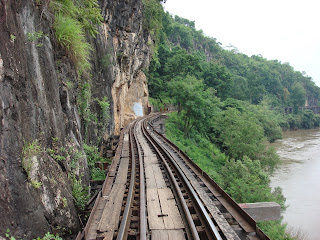All in all, our trip to Bangkok and its vicinity featured a few key sites, namely Kanchanaburi and its Death Railway and Bridge On The River Kwai as well as Ayutthaya and its ruins and not forgetting Bangkok itself. It was one exhilarating journey, quite a relaxing one but obnoxious at only one point of time (the bus ride from Ayutthaya on the way to going on a boat ride...which was laced with ammonia of the uric variety....urggh). Other than that encounter, everything else went well. Some more pictures below completing our Bangkok trip album on an amicable manner (captions provided below each pictures):
 The 1990s were witness to the most dramatic transformation in the city's history, with the skyline changing almost weekly. A village of a few dozen people has burgeoned into a throbbing city with around 10 million people. Apart from Chinatown, which has retained much of its cultural identity, most of the ethnic sections of the city have become homogenised. Bangkok has come to look more and more like modern cities everywhere in the world. With the dawn of the 21st century, improved management and new state-of-the-art mass transit systems (Skytrain) are signs that Bangkok is finally succeeding in its efforts to overcome its endemic transport problems (Discovery Channel)
The 1990s were witness to the most dramatic transformation in the city's history, with the skyline changing almost weekly. A village of a few dozen people has burgeoned into a throbbing city with around 10 million people. Apart from Chinatown, which has retained much of its cultural identity, most of the ethnic sections of the city have become homogenised. Bangkok has come to look more and more like modern cities everywhere in the world. With the dawn of the 21st century, improved management and new state-of-the-art mass transit systems (Skytrain) are signs that Bangkok is finally succeeding in its efforts to overcome its endemic transport problems (Discovery Channel)



 Once used as a royal summer retreat, Bang Pa-in, the former Summer Palace lies about 20km south of the ruins of Ayutthaya. The rulers of Ayutthaya used Bang Pa-in as long ago as the 17th century, but the buildings you see today date from the late 19th and early 20th century reigns of Rama IV (Mongkut) and Rama V (Chulalongkorn), who used to travel from Bangkok to this idyllic retreat in the countryside (Discovery Channel).
Once used as a royal summer retreat, Bang Pa-in, the former Summer Palace lies about 20km south of the ruins of Ayutthaya. The rulers of Ayutthaya used Bang Pa-in as long ago as the 17th century, but the buildings you see today date from the late 19th and early 20th century reigns of Rama IV (Mongkut) and Rama V (Chulalongkorn), who used to travel from Bangkok to this idyllic retreat in the countryside (Discovery Channel).The Chao Phraya River view from a boat
Anyhow, what made Bangkok unique, just like what made Sabah unique, is the people of Bangkok. Therefore, I would love to end this album with a snippet from Discovery Channel on the people of Bangkok:
"It is the people of Bangkok who infuse its bland concrete enclaves with energy and personality. The Thais' graciousness and charm give a vital dimension to a visit; often it is their smiles that are indelibly imprinted on a visitor's memory long after they return home. Who are these people and where did they come from? Discounting the prehistoric tribes who mysteriously disappeared, it is thought that the Thais originated in China and moved south from the 10th century onwards. Whatever their origins, Thai blood was augmented by infusions of Vietnamese, Cambodian, Laotian, Mon, Burmese, Malay, Japanese, Indian and even Persian, whose features are visible in many faces today.
The most prominent ethnic group, the Chinese, have managed to retain much of their original culture, and yet even these people have been rapidly absorbed into the Thai fabric. Thailand is rare among Asian countries in having avoided class, ethnic, religious or civil wars. A strong Thai sense of identity and independence has also helped the country avoid colonisation by foreign forces."
It is highly unlikely that I will be visiting Thailand anytime soon, having been to Phuket Island and now Bangkok and its vicinity, my curiosity of Thailand has been satiated quite sufficiently. I feel that it is time to set my eyes on someplace else in the future, perhaps Cambodia? Angkor Wat? Tomb Raider country....???
"It is the people of Bangkok who infuse its bland concrete enclaves with energy and personality. The Thais' graciousness and charm give a vital dimension to a visit; often it is their smiles that are indelibly imprinted on a visitor's memory long after they return home. Who are these people and where did they come from? Discounting the prehistoric tribes who mysteriously disappeared, it is thought that the Thais originated in China and moved south from the 10th century onwards. Whatever their origins, Thai blood was augmented by infusions of Vietnamese, Cambodian, Laotian, Mon, Burmese, Malay, Japanese, Indian and even Persian, whose features are visible in many faces today.
The most prominent ethnic group, the Chinese, have managed to retain much of their original culture, and yet even these people have been rapidly absorbed into the Thai fabric. Thailand is rare among Asian countries in having avoided class, ethnic, religious or civil wars. A strong Thai sense of identity and independence has also helped the country avoid colonisation by foreign forces."
It is highly unlikely that I will be visiting Thailand anytime soon, having been to Phuket Island and now Bangkok and its vicinity, my curiosity of Thailand has been satiated quite sufficiently. I feel that it is time to set my eyes on someplace else in the future, perhaps Cambodia? Angkor Wat? Tomb Raider country....???






























